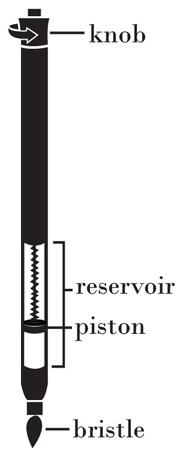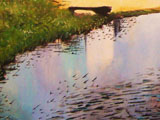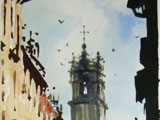
These water brushes use a piston filler, which you may fill with water, ink or liquid watercolors. great to work with half pans, watercolor pencils, soluble crayons, and pastels.
This basic set comes with three assorted bristles:
1. Leaf Vein Wolf Hair Stiff Brush B10
This brush is made of 100% natural weasel hair, which provide great flexibility and resiliency, spring back to a sharp point. A versatile detail brush that is suitable to draw veins on leaves, calyx of flowers and so on. It is known as "Leaf Vein" Brush in Chinese brush painting.
Brush tip size: 7/8"L, 3/8" D; Brush Length: 7 1/2"
2. SM White Cloud Sheep Hair Soft Brush B20
It is made of 100% natural sheep hair. A very useful soft hair for washes using side brush strokes. In Chinese it is called Baiyun or "white-cloud" brush, which is suitable to paint flower petals, birds feathers, and other small scale color washes.
Brush tip size: 1-1/8"L, 1/4" D; Brush Length: 7 3/4"
**You may order brush individually if you prefer(Prices are listed below).**
All three fountain brush pens come in black plastic handle with a transparent cap.The brush is very easy to clean, just squeeze out some water and brush it on a paper towel. Main care tip for the water brushes would be to clean and drain them before storing them when they are not going to be used for a while. I usually put them a in tooth brush box to store or carry to minimize evaporation and protect the brush tip.
Related Information Articles:
1) How to use the Piston Filler Waterbrush?
2) Alberto Giuliani's Watercolor Paintings done with BHA Brushes


Product review: My observations on the Waterbrush Update (October 2011):
There is a new type of waterbrush on the market now by Blue Heron Arts that uses a piston filling mechanism. It comes in both a long model for painting at home and a portable pocket version (in the photo below) which has me excited because it is so portable and looks good in the pocket as well.
The bristles look and feel the same as soft traditional brushes, so you can use many of the same techniques you could do with a regular brush which are not so easy with stiff white bristles on the squeeze type waterbrushes mentioned above.
The piston also gives you better control over the water flow, even to the point of stopping the flow completely for dry techniques, and you can turn it with one hand alone by grasping the end knob with your little and ring finger and rotating the barrel with your thumb and index finger. You can also post the cap and turn it, which will then turn the knob, but I prefer to use it with no cap posted because it seems better balanced and easier to handle that way.
One draw back is that the piston takes up so much room, this pocket version will run out of water before you can finish an average size sketch. But it is perfect for trading card size sketches (ATC and ACEO) as well as postcard size sketches. Of course, you can also take a few waterbrushes with you to make sure you don't run out of water.
Although you can turn the piston with one hand, use two hands to uncap the water brush barrel don't try it with one hand because it can snap the pen in two. I know because I did it!
These waterbrushes come in two tip sizes, the larger one (model number A20) is a good general size for small sketches, and the other one (model number A10) has an even smaller point, similar to a brush pen, and I suspect it was intended detail work or even filling with ink to use as a brush pen. I ordered one of each, used them for a week, and then ordered a few more of the model with the larger tip (model number A20 ) since they are inexpensive and it's good to have a few in my bag.
) since they are inexpensive and it's good to have a few in my bag.
The one problem I have encountered with these is the fact that water can come out the sides of the black plastic section that holds the bristles. There is a some kind of air vent on the larger of the two, and two vents on the smaller one. They don't seem necessary, and caused water to come out the sides when I wanted it to come out the tip. After I plugged them up, the flow was much more predictable, and these brushes do exactly what I want, and work like a dream. I used J-B weld since it was handy -- it's dark gray and barely visible in the photo (every handyman should have a few tubes of J-B Weld sitting in a drawer somewhere).
The maker says to fill these by pointing the pen downward and submerging the tip in a glass of water, but I'm lazy, so I just hold them upright under a faucet with running water and turn the piston knob to fill up the barrel. That works well for both piston and squeeze type waterbrushes.